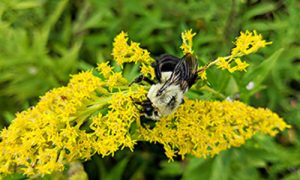Bees that were buzzing around the nation’s wildflowers more than a century ago are now helping researchers understand how deeply their ranks have diminished over the years, how it happened and – most importantly – what Patrick County gardeners and farmers can do about it now.
 The research is being conducted at the E.S. George Reserve, a 1,300-acre reserve, about 25 miles from the University of Michigan’s Ann Arbor campus. The Reserve is administered by the University’s Department of Ecology and Evolutionary Biology. The researchers analyzed bee samples taken as early as 1921.
The research is being conducted at the E.S. George Reserve, a 1,300-acre reserve, about 25 miles from the University of Michigan’s Ann Arbor campus. The Reserve is administered by the University’s Department of Ecology and Evolutionary Biology. The researchers analyzed bee samples taken as early as 1921.
Three things make this research uniquely valuable. First, it proves the value of advanced computer analysis in the field of ecology.
Second, the long-term trends in bee populations, placed parallel to trends in their natural habitats, point to enhanced conservation approaches. That includes the current shifting of planting zones southward into lower numbers. Patrick County gardeners and farmers aiming to maximize long-term attraction of bumble bees might consider pushing that envelope, selecting perennials that are recommended for zone 7b and lower. That would tend to maximize the return-on-investment for new plants, and stabilize the bumble bee environment over the long term.
Third, and perhaps most important, it spotlights the importance of implementing conservation measures as quickly as possible. Already, the researchers have found, the populations of 64% of North America’s more common bee species have declined by nearly a third (30%).
The lost bees
Most of them are bumble bees, the dawn-to-dusk, March-to-October pollinating workhorses in gardens and fields.
The Xerces Society, an international nonprofit focused on the conservation of invertebrates and their habitats, estimates that more than a quarter of North America’s 46 bumble bee species – all ground nesters – face some degree of extinction risk. More than 90 percent of bumble bees lead solitary — rather than social — lives, in which each female constructs and provisions her own nest, without the assistance of others. Most are not aggressive; in fact, many are stingless.
Rather than categorizing their subjects by their social habits, the University of Michigan researchers use a more critical factor – their pollen collection strategies:
oligolectic bees (those that collect pollen from a few types of plants and nest in the ground –i.e., bumble bees)
kleptoparasitic bees (they steal food from other bees)
polylectic bees (those that collect pollen from various plants and nest in cavities). Think honey bees, although these highly valued pollinators aren’t really native at all.
Now consider that 46 bumble bee species means at 46 different sets of adaptations for collecting pollen and nectar. There are a lot of factors in these adaptation sets but tongue length has been considered especially significant. Most bumble bees are long-tongued but some – Virginia’s brown belted bumble bee for instance – have shorter tongues than others. It all relates to the depth of the flowers the bees visit.
Subhead: Keep them at home
Lupines are especially popular with some bumble bee species; lamb’s ear, with another. The easiest solution: incorporate a variety of flowers, paying special attention to cover that March-to-October calendar.
For early- to mid-spring, look at rattlesnake master, veronica, thyme, Lewisia and fruit trees. Consider aubrieta as well. Even though it (like the honey bee) is not a true native, it has proven useful and non-invasive.
For late summer and fall, look at asters, goldenrod, Agastache and echinacea.
For all those in-between months, look at flowers with deep blossoms. There’s a lot to choose from, including honeysuckle, iris, roses, sage and snapdragon.
That may be the most important of the Michigan researchers’ conclusions. Bumble bees are more likely to remain in locations that meet their needs.




